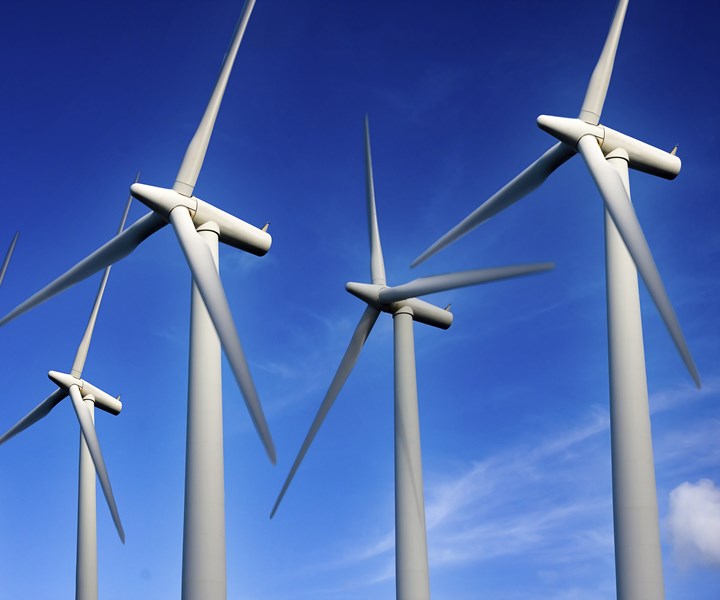GWEC reports more than 60 GW new wind energy capacity in 2019
According to the Global Wind Energy Council’s recently released market report, 2019 was the second-largest year for wind power growth, up 19% over 2018.

The Global Wind Energy Council (GWEC, Brussels, Belgium) has published the 15th edition of its Global Wind Report, a publication which provides a comprehensive, global view of the sector through the latest market data, country profiles, trends and analysis. According to the report, 2019 was the second biggest year for wind power historically, with installations of 60.4 gigawatts of new capacity worldwide and year-on-year growth of 19%.
The GWEC says that the main driver of this growth was market-based mechanisms, with auctioned wind capacity in 2019 surpassing 40 gigawatts worldwide, accounting for two-thirds of total new capacity and doubling auctioned capacity compared to 2018.
The majority of wind energy installations in 2019 were located in established markets, with the top five markets (China, the U.S., the U.K., India and Spain) accounting for 70% of new capacity. In terms of cumulative installations, China, the U.S., Germany, India and Spain remain the top markets, collectively making up 73 % of the total 651 gigawatts of wind power capacity across the world.
According to the GWEC, 2020 was expected to be a record year for wind energy, with a forecasted 76 gigawatts of new capacity. However, the full impact of COVID-19 on wind energy installations is still unknown. GWEC will revise its 2020-2024 forecast in the light of the potential impacts of COVID-19 on the global economy and energy markets, and will publish an updated market outlook in the second quarter of 2020.
“The wind energy sector is continuing to see consistent growth … [W]e see emerging markets in regions such as South East Asia, Latin America and Africa playing an increasingly important role in the years to come, while offshore wind is also becoming a significant growth driver,” says Ben Backwell, CEO at GWEC.
The Asia Pacific region was the global leader for new onshore wind installations in 2019, installing 28.1 gigawatts of new capacity, more than half of the total new global capacity. Despite a slump in Germany’s wind market, Europe still saw a 30% year-on-year growth for its onshore wind market, driven by strong growth in Spain, Sweden and Greece. Emerging markets for wind in Africa, the Middle East, Latin America and South East Asia also showed moderate growth in 2019, with combined installations of 4.5 gigawatts.
Looking to offshore wind, the GWEC says that 2019 was a record year for the sector with 6.1 gigawatts installed and now accounting for 10% of total wind installations globally. This growth was led by China, which remains in the number-one position for new offshore capacity with 2.3 gigawatts installed in 2019. In terms of cumulative offshore wind capacity, the U.K. remains in the top spot with 9.7 gigawatts, accounting for nearly one-third of the 29.1 gigawatts of total global capacity.
The report forecasts that this growth will continue, with over 355 gigwatts of wind energy capacity added over the next five years. This would mean that we would see 71 gigawatts of wind energy added each year to the end of 2024, with offshore wind expanding its share of total wind energy installations to 20% by that time.
“... In 2019, we continued to see more and more countries transitioning away from Feed-in-Tariffs to market-based mechanisms, as well as continued growth in the corporate PPA market. Additionally, new technology developments such as hybridization and green hydrogen are increasingly being implemented in both mature and emerging markets to increase the share of wind and other renewables in their energy systems. If policymakers and industry stakeholders embrace these new opportunities, we can accelerate the global energy transition to never-before-seen levels,” says Feng Zhao, strategy director at GWEC.
Related Content
Recycling end-of-life composite parts: New methods, markets
From infrastructure solutions to consumer products, Polish recycler Anmet and Netherlands-based researchers are developing new methods for repurposing wind turbine blades and other composite parts.
Read MoreHonda begins production of 2025 CR-V e:FCEV with Type 4 hydrogen tanks in U.S.
Model includes new technologies produced at Performance Manufacturing Center (PMC) in Marysville, Ohio, which is part of Honda hydrogen business strategy that includes Class 8 trucks.
Read MoreHexagon Purus opens new U.S. facility to manufacture composite hydrogen tanks
CW attends the opening of Westminster, Maryland, site and shares the company’s history, vision and leading role in H2 storage systems.
Read MoreNovel composite technology replaces welded joints in tubular structures
The Tree Composites TC-joint replaces traditional welding in jacket foundations for offshore wind turbine generator applications, advancing the world’s quest for fast, sustainable energy deployment.
Read MoreRead Next
Plant tour: Daher Shap’in TechCenter and composites production plant, Saint-Aignan-de-Grandlieu, France
Co-located R&D and production advance OOA thermosets, thermoplastics, welding, recycling and digital technologies for faster processing and certification of lighter, more sustainable composites.
Read MoreVIDEO: High-volume processing for fiberglass components
Cannon Ergos, a company specializing in high-ton presses and equipment for composites fabrication and plastics processing, displayed automotive and industrial components at CAMX 2024.
Read MoreDeveloping bonded composite repair for ships, offshore units
Bureau Veritas and industry partners issue guidelines and pave the way for certification via StrengthBond Offshore project.
Read More
.jpg;width=70;height=70;mode=crop)









.jpg;maxWidth=300;quality=90)












